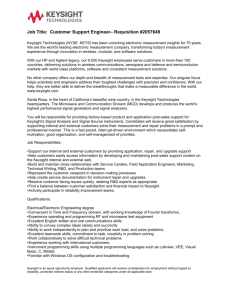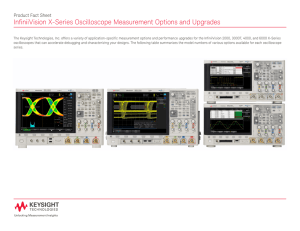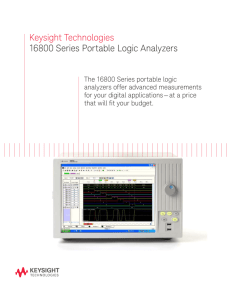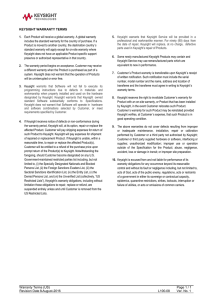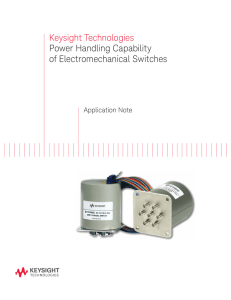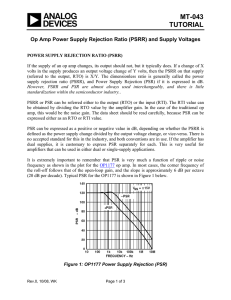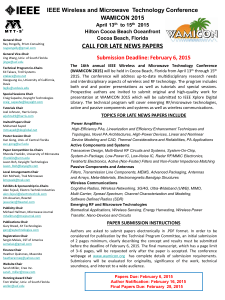Keysight Technologies Power Supply Rejection Ratio (PSRR
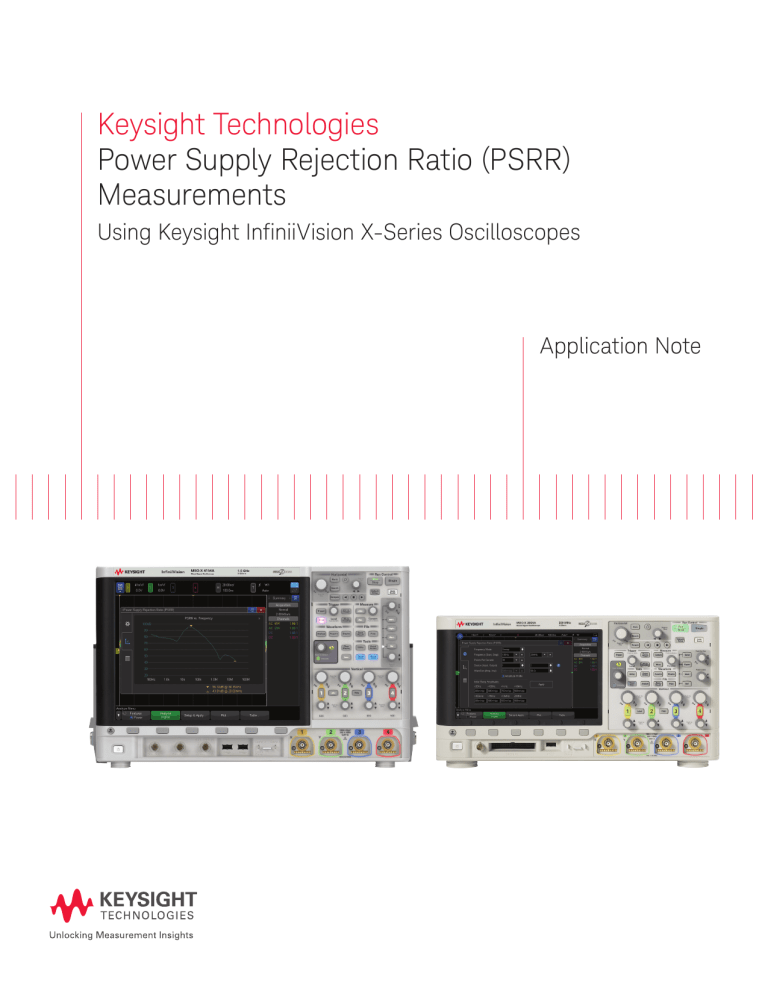
Keysight Technologies
Power Supply Rejection Ratio (PSRR)
Measurements
Using Keysight InfiniiVision X-Series Oscilloscopes
Application Note
Introduction
The primary measurement tool used to test and characterize power supplies is an oscilloscope. Many of today’s scopes, including the Keysight Technologies, Inc. InfiniiVision X-Series, offer special power measurement options that can help automate many of the most important measurements. Figure 1 shows a list of the power supply characterization measurements that are available on Keysight’s InfiniiVision
3000T and 4000 X-Series oscilloscopes with the power measurements option (DSOX3PWR or DSOX4PWR).
Unique to Keysight’s portfolio of measurements are frequency response measurements including power supply rejection ratio (PSRR) and control loop response (Bode). These particular stimulus-response type measurements are typically performed using low-frequency network analyzers. But since Keysight’s
InfiniiVision X-Series oscilloscopes come with a built-in function/arbitrary waveform generator, they can also be performed using these scopes.
Figure 1. Power supply characterization measurements available in Keysight’s InfiniiVision X-Series oscilloscopes.
03 | Keysight | Power Supply Rejection Ratio (PSRR) Measurements - Application Note
Power Supply Rejection Ratio (PSRR)
Figure 2 shows a block diagram of a PSRR measurement test setup. This test provides a measure of how well a power delivery device, such as a DC-to-DC converter or a low-voltage drop-out regulator (LDO), rejects various frequency components injected at the DC input of the device-under-test. In other words, how much of a disturbance signal injected at the DC input reaches the regulated DC output.
To perform a PSRR test, a sine wave must be injected at the DC input and then swept from a low frequency to a high frequency. A DC + AC network summing device, such as Picotest’s
J2120A line injector, is required for this measurement. The measurement system measures both the modulated input and output AC voltage levels and then computes the rejection ratio as 20Log(V in
/V out
) at each frequency within the swept band. Some engineers argue that the formula should be 20Log(V out
/V in
). But this is the formula for gain (A), not rejection. Rejection is the inverse of gain. The built-in waveform generator along with the Power Measurements option in Keysight’s InfiniiVision X-Series oscilloscopes makes this frequency response measurement possible for the first time in an oscilloscope.
Figure 2. Block diagram of a power supply rejection ratio (PSRR) measurement on a low-voltage drop out regulator.
04 | Keysight | Power Supply Rejection Ratio (PSRR) Measurements - Application Note
Probing the Input and Output
Although a standard 10:1 passive probe can be used to probe the modulated DC input, a 1:1 passive probe, such as the Keysight Technologies, Inc. N2870A, is recommended to probe the output. Assuming that the DC-to-DC converter under test has lots of rejection, the amplitude of output will be very small (sub millivolts). In addition, properly grounding the probe near the
DC output test point is important. If you use the standard ground lead that comes with your 1:1 passive probe, it will act as an antenna and pick up a significant amount of noise in the air and thereby reduce the dynamic range of your measurement. A short spring clip ground adapter
(usually shipped as an accessory with the probe and shown in the inset image of Figure 3), or better yet, a soldered-in probe socket will provide the best low-noise signal fidelity.
Figure 3 shows a photo of actual test set up of a PSRR measurement on a Picotest 3.3V linear regulator evaluation board using a Picotest J2120A line injector as the input summing device.
Note the probe socket used on the output probing point for a solid ground connection (no antenna).
Figure 3. Probing the DC-to-DC converter using two channels of the oscilloscope.
05 | Keysight | Power Supply Rejection Ratio (PSRR) Measurements - Application Note
Performing the PSRR Measurement
To perform this PSRR test using an InfiniiVision X-Series oscilloscope with the power measurements option, first select the PSRR measurement from the list of possible power supply related measurements, and then select the Setup & Apply menu shown in Figure 4. We will begin this measurement using a fixed test amplitude of 130 mVpp to modulate the DC input as shown in Figure 4. Next, press Apply to begin the test.
Figure 4. Establishing the PSSR test parameters.
06 | Keysight | Power Supply Rejection Ratio (PSRR) Measurements - Application Note
Performing the PSRR Measurement (Continued)
Figure 5 shows the plot of rejection after the completion of the test. In this plot of results we can see what appears to be chatter at the lower test frequencies. This chatter is evidence that our SNR may be too low at some test frequencies. One method of improving SNR is to simply increase the test amplitude at all frequencies. However, increased test amplitudes can sometimes induce distortion as some test frequencies.
Figure 5. Initial PSRR test shows chatter using a fixed test amplitude of 130 mVpp.
07 | Keysight | Power Supply Rejection Ratio (PSRR) Measurements - Application Note
Performing the PSRR Measurement (Continued)
A better solution to improve SNR is to customize test amplitudes using the amplitude profile capability of this measurement tool shown in Figure 7. With amplitude profiling, you can test at lower amplitudes at frequencies where the DUT is sensitive and test at higher amplitudes where it is less sensitive to distortion.
Figure 6. Using amplitude profiling to optimize signal-to-noise ratio.
08 | Keysight | Power Supply Rejection Ratio (PSRR) Measurements - Application Note
Performing the PSRR Measurement (Continued)
Figure 8 shows the PSRR measurement based on the use of a customized test amplitude.
Notice that the chatter due to insufficient signal-to-noise ratio has been significantly minimized. Using the cursors after the completion of the test, we measure a maximum rejection of 95 dB at 34.15 kHz and a minimum rejection of 43.5 dB at 20 MHz (final test frequency).
So how do you determine optimum test amplitudes? One advantage of Keysight’s scope-based solution is that you often can observe distortion in the time-domain waveform during the test. If the output sine wave begins to look loop-sided, clipped, or somewhat triangular in shape (non-sinusoidal), then you are probably encountering distortion due to overdriving your
DUT. Optimizing test amplitudes to achieve the best dynamic range measurements often is an iterative process of running your frequency response measurements multiple times. With
Keysight’s oscilloscope-based frequency response measurements, you typically will go through fewer iterations.
Note that you also can perform a PSRR measurement at a single frequency using Keysight’s oscilloscope-based solution. This allows you to run a test a single frequency and then make manual amplitude and frequency adjustments within the scope’s WaveGen setup menu while visually monitoring repetitive time-domain waveforms on the oscilloscope’s display.
Figure 7. PSRR measurement using optimized test amplitudes.
09 | Keysight | Power Supply Rejection Ratio (PSRR) Measurements - Application Note
Summary
Oscilloscopes are the primary measurement tools used today by engineers to test and characterize their power supply designs. But most scopes have significant limitations when it comes to performing frequency response measurements such as power supply rejection ratio
(PSRR). Keysight’s InfiniiVision X-Series oscilloscopes are the first scopes on the market that can perform PSRR measurements automatically.
System Requirements
A PSRR test on a Keysight InfiniiVision 3000T, 4000, or 6000 X-Series oscilloscope requires that the scope be licensed with the power measurements option (DSOX3PWR, DSOX4PWR, or DSOX6PWR). The WaveGen option is not required. The scope will automatically turn on the
WaveGen for the one-time PSRR measurement. A 1:1 passive probe, such as the N2870A, is recommended for probing the low-level output signal. Coupling the input disturbance signal from the scope’s WaveGen output into the DC input requires a network summing device such as Picotest’s J2120A Line Injector. For more information about this product, contact Picotest at www.picotest.com
In addition to the above listed minimum system requirements, it is recommended that your
3000T or 4000 X-Series oscilloscope be running on firmware version 4.08 or greater.
Related Literature
Publication title
InfiniiVision 3000T X-Series Oscilloscopes - Data Sheet
InfiniiVision 4000 X-Series Oscilloscopes - Data Sheet
Publication number
5992-0140EN
5991-1103EN
InfiniiVision 6000 X-Series Oscilloscopes - Data Sheet
InfiniiVision Oscilloscope Probes and Accessories - Selection Guide
5991-4087EN
5968-8153EN
Power Supply Control Loop Response (Bode Plot) Measurements - Application Note 5992-0593EN
Switch Mode Power Supply Measurements - Application Note
Making Your Best Power Integrity Measurements - Application Note
5991-1117EN
5992-0493EN
5989-6755EN Tips and Techniques for Making Power Supply Noise Measurements with an
Oscilloscope - Application Note
Evaluating Oscilloscopes for Low-Power Measurements - Application Note
New Probing Technology Enables High Sensitivity, Wide Dynamic Range Current
Measurement – Application Note
5991-4268EN
5991-1951EN
10 | Keysight | Power Supply Rejection Ratio (PSRR) Measurements - Application Note www.axiestandard.org
AdvancedTCA ® Extensions for Instrumentation and Test (AXIe) is an open standard that extends the AdvancedTCA for general purpose and semiconductor test. The business that became Keysight was a founding member of the AXIe consortium. ATCA ® , AdvancedTCA ® , and the ATCA logo are registered US trademarks of the PCI Industrial Computer Manufacturers
Group. www.lxistandard.org
LAN eXtensions for Instruments puts the power of Ethernet and the Web inside your test systems. The business that became Keysight was a founding member of the LXI consortium.
www.pxisa.org
PCI eXtensions for Instrumentation (PXI) modular instrumentation delivers a rugged, PC-based high-performance measurement and automation system.
11 | Keysight | Power Supply Rejection Ratio (PSRR) Measurements - Application Note
Evolving
Our unique combination of hardware, software, support, and people can help you reach your next breakthrough. We are unlocking the future of technology.
From Hewlett-Packard to Agilent to Keysight
KEYSIGHT
SERVICES
myKeysight www.keysight.com/find/mykeysight
A personalized view into the information most relevant to you.
Keysight Infoline www.keysight.com/find/Infoline
Keysight’s insight to best in class information management. Free access to your Keysight equipment company reports and e-library.
Keysight Services www.keysight.com/find/service
Our deep offering in design, test, and measurement services deploys an industry-leading array of people, processes, and tools. The result? We help you implement new technologies and engineer improved processes that lower costs.
Three-Year Warranty www.keysight.com/find/ThreeYearWarranty
Keysight’s committed to superior product quality and lower total cost of ownership. Keysight is the only test and measurement company with three-year warranty standard on all instruments, worldwide. And, we provide a one-year warranty on many accessories, calibration devices, systems and custom products.
Keysight Assurance Plans www.keysight.com/find/AssurancePlans
Up to ten years of protection and no budgetary surprises to ensure your instruments are operating to specification, so you can rely on accurate measurements.
Keysight Channel Partners www.keysight.com/find/channelpartners
Get the best of both worlds: Keysight’s measurement expertise and product breadth, combined with channel partner convenience.
www.keysight.com/find/scopes-power
For more information on Keysight
Technologies’ products, applications or services, please contact your local Keysight office. The complete list is available at: www.keysight.com/find/contactus
Americas
Canada
Brazil
Mexico
United States
(877) 894 4414
55 11 3351 7010
001 800 254 2440
(800) 829 4444
Asia Pacific
Australia
China
Hong Kong
India
Japan
Korea
Malaysia
Singapore
Taiwan
Other AP Countries
1 800 629 485
800 810 0189
800 938 693
1 800 11 2626
0120 (421) 345
080 769 0800
1 800 888 848
1 800 375 8100
0800 047 866
(65) 6375 8100
Europe & Middle East
Austria
Belgium
Finland
France
Germany
Ireland
Israel
Italy
Luxembourg
Netherlands
Russia
Spain
Sweden
Switzerland
United Kingdom
0800 001122
0800 58580
0800 523252
0805 980333
0800 6270999
1800 832700
1 809 343051
800 599100
+32 800 58580
0800 0233200
8800 5009286
800 000154
0200 882255
0800 805353
Opt. 1 (DE)
Opt. 2 (FR)
Opt. 3 (IT)
0800 0260637
For other unlisted countries: www.keysight.com/find/contactus
(BP-06-08-16)
DEKRA Certified
ISO9001 Quality Management System www.keysight.com/go/quality
Keysight Technologies, Inc.
DEKRA Certified ISO 9001:2015
Quality Management System
This information is subject to change without notice.
© Keysight Technologies, 2015 - 2016
Published in USA, July 15, 2016
5992-0594EN www.keysight.com
